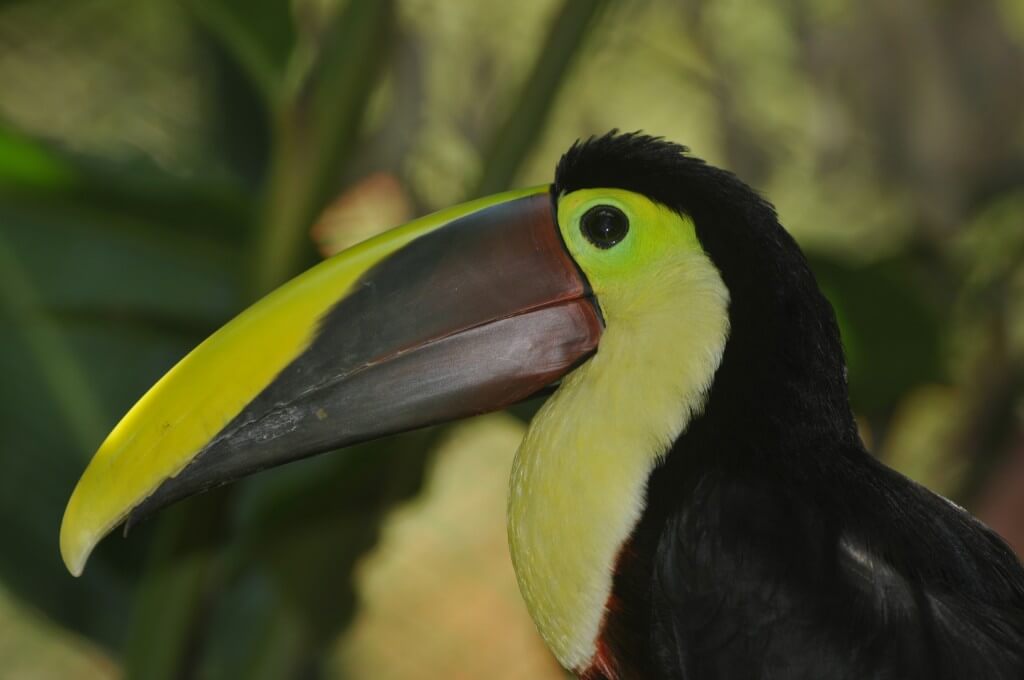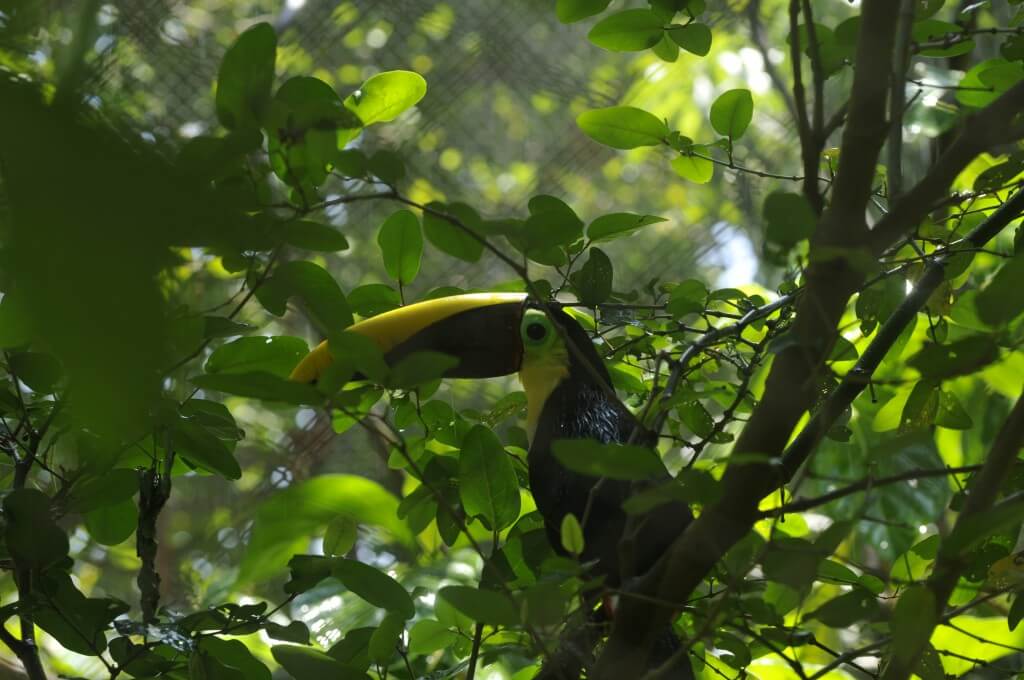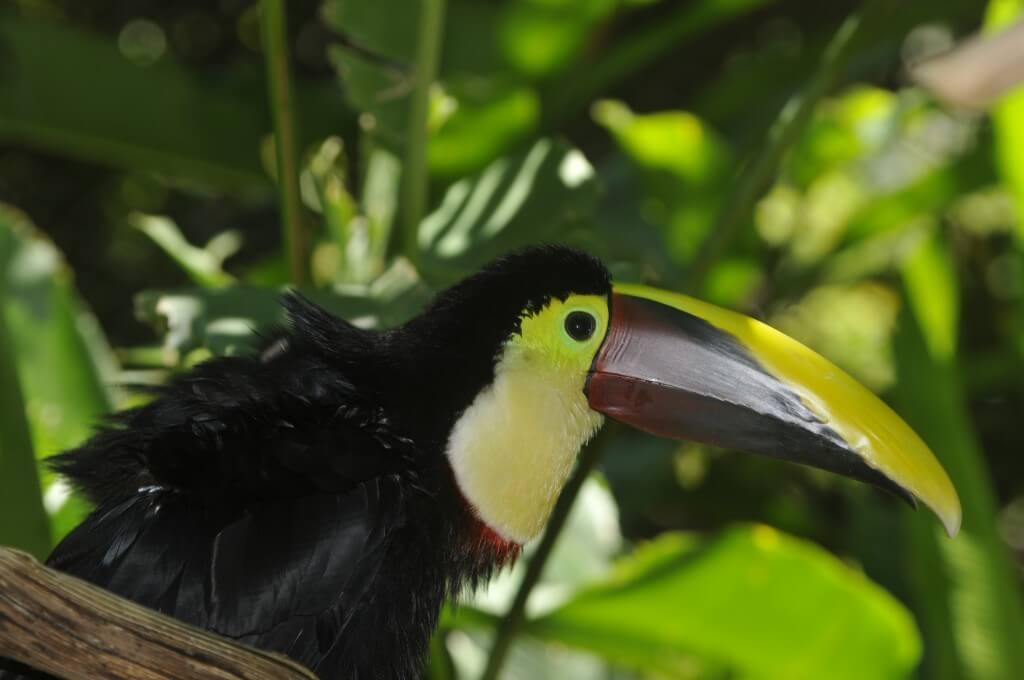Toucans of Costa Rica
Scientific names: Ramphastos sulfuratus and Ramphastos ambiguus.
Distribution range: From Mexico in North America to Argentina in South America.
Abstract
Toucans are small birds that live in tropical forests. These birds are important for the ecosystem because they disperse the seeds of fruits.
Toucans are the face of tourist publicity and birdwatcher groups. Furthermore, they are linked with the rainy season in popular traditions, and people who live in rural areas say that the sound of the toucan is a sign that rain is coming.
In the Sanctuary of Macaws NATUWA, we disagree with using wildlife as pets, and we work to rescue animals like toucans from people who traffic them.


Why do Toucans have so many colors on their body? Why are Toucans colorful birds?
Colors in the wild have different purposes. Some animals use their colors to get attention from females, and others use the colors as a warning to scare away predators.
Birds have excellent sight and their eyes can see colors that other animals can not. So, the colorful toucans’ beak can be a signal to say: “Hey, I am a male. I am looking for a couple. I am healthy”.
Moreover, the colors on the toucans’ bodies provide them camouflage that can confuse their predators, because they live in forests with trees that have colorful leaves and fruits.
Toucans in Costa Rica
In different parts of the country, toucans are called “Rey Curré”, “Curré”, “Curraré”, “Tucancillo” and other names.
Toucans live in tropical forests or rainforests, and they are very common to see flying across the sky during the early morning.
Farmers and elderly people say that toucans sing only when the rain is coming. They also say when a toucan is standing on a tree without leaves it is going to be a sunny day and when the toucan is standing on a tree with many leaves it is going to be a rainy day.
These beautiful birds are used in pictures to represent biodiversity, and people who see those images recognize toucans as synonymous with birdwatching and tourism.







Toucans' Natural History
The Piciformes Order includes birds that eat insects, but they do not catch them when the insects are flying. They do it by pecking the wood of the trees and catching them with their long tongues1.
Ramphastidae Family is part of this Order with six species of Toucans in Costa Rica: Aulacorhynchus prasinus, Pteroglossus frantzii, Pteroglossus torquatus, Ramphastos sulfuratus, Ramphastos ambiguus and Selenidera spectabilis.
In the Sanctuary of Macaws NATUWA, we take care of two species of toucans: R. sulfuratus and R. ambiguus.
R. sulfuratus has a colorful beak with green, light blue, brown, and orange. The back, wings, and tail are black with some red-white colored feathers. Its belly is yellow and its feet are blue2. R. ambiguus looks like R. sulfuratus because both have the same color, but R. ambiguus’ beak is only brown-yellow colored3.
In general, toucans eat fruits, like papaya and bananas, and disperse the seeds in the forest. They also eat little vertebrates like insects, lizards, and toads. R. ambiguus also eats the eggs and offsprings of other birds.
R.sulfuratus and R. ambiguus have between two and four eggs. Both parents take care of them and change roles until the offspring leave the nest after two months2. The “Curré” lives in forests near rivers, and make groups of six members5.
Some of their predators are jaguars, snakes, owls, falcons, and eagles3.
Management, Diet and Enrichment.
Toucans need a space to fly between trees and branches to make a nest. The enclosure where they live must have plants, grass, and wood where they can find insects to eat.
Their diet includes fruits, seeds, and berries and it needs to be complemented with iron and calcium3.
As part of their enrichment, our workers put some fruits inside the enclosure but they must not be peeled because in that way the birds can use the beak to peel them. If toucans in captivity do not use their beak as they normally do in the wild, their beak will grow and become so sharp the birds could hurt themself.
The “Curraré” is a key part of the environmental education process because it can be used as an example of the beautiful biodiversity we have in our country, and at the same time, to teach people that wildlife must not be used as pets.










Seven interesting Facts About the "Tucancillo"
1) The “Rey Curré” (R, sulfuratus) is the national bird of Belize.
2) Toucans make their nest in holes in the trees, and return to nest in the same hole every year3.
3) In the wild, this bird can live up to 18 years, but in captivity, it can live up to 20 years3.
4) How do toucans defend themself from predators? They lift the beak and shake it up and down to say they want to fight3.
5) Like other birds, when the offspring are born, they are naked and blind, but after three weeks they will open their eyes3.
6) Toucans’ beak is made of keratin and they can use it as a tool to catch insects and peel fruits, but it is not good for fighting because it is very soft, light, and hollow.
7) The IUCN describes the toucans as a Least Concerned species on the Red List because it has a broad distribution range. However, it is threatened by deforestation and wildlife trafficking.
Message
In the Sanctuary of Macaws NATUWA, we disagree with using wildlife as pets, and we work to rescue animals like toucans from people who traffic them.
References.
1Barrientos, Z. (2008). Zoología General. San Jose, Costa Rica: EUNED.
2BioEnciclopedia. (2016). El Tucán. [Video Archive]. Retrieved from: https://www.youtube.com/watch?v=Gk83mbKjeBI
3Museo Nacional de Costa Rica. (2013). Ramphastos ambiguus. Retrieved from: http://ecobiosis.museocostarica.go.cr/especies/Buscador.aspx
4Desconocido. (Sin fecha). Los Tucanes. Aprendamos de los tucanes con las tucanicas. Retrieved from: http://webcache.googleusercontent.com/search?q=cache:78l_n_xxhQkJ:www.atlasdeladiversidad.net/sites/default/files/documents/diapositivas%2520de%2520los%2520tucanes_0.pdf+&cd=3&hl=es-419&ct=clnk&gl=cr&client=firefox-b-d
5National Geographic. (No date). Tucán. Retrieved from: https://www.nationalgeographic.es/animales/tucan
6Universidad ICESI. (2010). Tucán Guarumero-Ramphastos ambiguus. Retrieved from: https://www.icesi.edu.co/wiki_aves_colombia/tiki-index.php?page=Tuc%C3%A1n+Guarumero+-+Ramphastos+ambiguus&structure=Toritos%2C+tucanes+y+carpinteros


